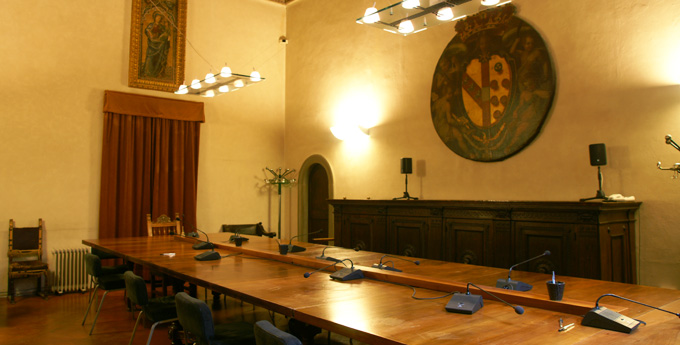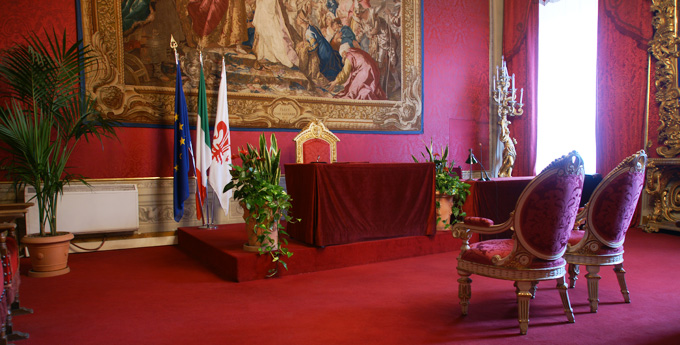Rooms of Palazzo Vecchio
Palazzo Vecchio is the name of the building that houses Florence’s city government. It has served this role from the start of its construction in 1290, although it was first called Palazzo della Signoria (the name you see reflected in the current piazza of the same name).
Much of Palazzo Vecchio is open to the public and can be visited as a museum. For more information visit the website of the Civic Museums of Florence.
Other parts of the building are not part of the regular tourist visit because they are in use by the city government, either as offices or as locations for important council meetings. The following are the main rooms used for these purposes.
Il Salone dei Cinquecento (The Hall of the Five Hundred)
The origins of the Great Hall of the Five Hundred date back to a room built at the end of the fifteenth century to accommodate the meetings of the Florentine Council that were previously held in the Sala dei Duecento. In 1494, the Florentines had banished the Medici from the city and, on the suggestion of Girolamo Savonarola, proclaimed a new Republic that called for increased participation of the government through the institution of a Great Council consisting of more than 3,000 citizens. Even though the number was reduced to 1,000 representatives that met in two rotations of 500, the reform made it necessary to build a new hall big enough to accommodate the newly increased numbers. The room was modeled on the Hall of the Republic of Venice's Upper Council.
The “new hall,” built by Simone del Pollaiolo with the cooperation of other architects, was already in use in 1496. It occupied the current space of the Salone, but was lower by some seven metres, with windows on all sides, an altar on the western wall and, on the opposite wall, a tribune for the Signoria, flanked by two doors that led to the “Segreto” (the room where ballots were counted), and to the “Specchio”, where the Republic's debtor's registers were kept.
The use of the hall as a meeting room for the Council was brought to an end when the Medici re-entered the city in 1512, but was returned during the years of the second Republic, 1527 to 1530. Once the Medici returned to power, they debased the hall's role by using it as lodging for guards, until Cosimo I moved to Palazzo Vecchio in 1540 and transformed it into the magnificent room we see today. Then, it was primarily used for the Duke's public ceremonies and was the visual centrepiece of the celebration of his glory.
By the time the renovation and redecoration of the room was complete, the ducal court had already begun its move to Palazzo Pitti. Cosimo's successors continued to use the hall for parties and solemn ceremonies and continued enrich it with ornamental decoration. Three centuries passed before the room regained its ancient function of parliamentary hall, when it hosted the 1848 meeting of the Tuscan Legislative Body. In 1859, it hosted the Assembly constituted after the fall of the Lorena Grand-Dukes, and from 1865 to 1871 during the years that Florence was capital of the Kingdom of Italy, it was used as the Deputies' Chamber.
The City of Florence wanted to return the magnificence of the Granducal period and make the hall an integral part of visits to the Palazzo Vecchio museum, while continuing to use it as seat for important ceremonies and events, recognizing its traditional role as centre of public Florentine life. Thus this room can be visited by the public (it is at the start of the museum path), although sometimes it is in use for special events or conferences.

Il Salone dei Cinquecento
La Sala dei Duecento (The Hall of the Two Hundred)
This large hall belongs to the oldest part of the Palazzo, built between 1299 and the first two decades of the following century. Built to accommodate meetings of the Citizen Council, it got its current name in the sixteenth century when Duke Alessandro de' Medici reformed the popular assembly and increased its number to 200.
Entrance to the room was originally gained from the primary courtyard. It had a separate recess—called the “Secret”—for counting ballots, an altar and high-backed chairs for the Signoria. The layout is depicted in the painting by Vasari that you can see on the ceiling of the Salone dei Cinquecento, representing the Orazione di Antonio Giacomini per la Guerra di Pisa (Prayer of Antonio Giacomini for the War with Pisa). Based on the date of this painting, we can assume that this room already featured the precious wood stage with lacunar insets of rosettes surrounded by Angevin lilies, the freeze with garlands and shields bearing the city's emblem that Giuliano da Maiano and his collaborators carved in the 1480s.
During the Republican era, from 1496 to 1512, and again from 1527 to 1530, the Council met in the room that had been created especially to hold its increasing members, the Salone dei Cinquecento. The “old hall” was used for Senate meetings. After the return of the Medici, the hall regained its original purpose, even though it was for a different Council than the original 200 members. The hall was used until the rise of Cosimo I and the transfer of the ducal court to Palazzo Vecchio in 1540, when he declared a swift end to the original functions of the Palazzo as citizen magistracy.
During this period, a series of precious tapestries featuring the Stories of Joseph were commissioned by Cosimo I to decorate the hall during special occasions. Part of the series is now displayed in the Palazzo del Quirinale in Rome; another portion hangs in the restoration workshops in Palazzo Vecchio. During the short-lived Liberal movements of 1848, the room returned to the centre of the city's political life as the Senate chambers. Only in 1872, after the Palazzo was ceded to the City of Florence, did it regain its ancient and prestigious role as the seat of the Citizen Council.

La Sala dei Duecento
La Sala degli Otto (The Hall of the Eight)
The Sala degli Otto is bordered to the north by the shelter that connects the Salone dei Cinquecento to the Sala dei Duecento, and on the other three sides by the Palazzo's monumental staircases. It is reached both through the eastern side of the Sala dei Duecento and through a hallway.
The origins of this room are uncertain. Its name comes from the Otto di Guardia or Otto di Pratica, a magistracy with the function of ensuring public safety instituted in 1378, though its origins are unknown. According to one hypothesis, which cannot be verified by historical and critical research, the Otto di Guardia used the room from its inception. According to another hypothesis, the room was the Camera dell'Udienza, with a chancellery annex, and thus would have been built for the magistracy in 1528, in substitution of another smaller space.
The room has a wood panelled ceiling, decorated with rosettes surrounded by Angevin lilies, that was most certainly created in the late fifteenth century by Giuliano da Maiano and his assistants. If the room actually dates to the 16th century, it is likely that this wood ceiling was moved into this room from a different location.
The Magistratura degli Otto, moved to the Bargello and stripped of its authority by Cosimo I de' Medici, was definitively abolished in 1777. For most of the twentieth century, the room was used as a service hall for the adjacent Sala dei Duecento. When the City's mayoral committee began meeting there, the hall regained a function worthy of its illustrious past.

La Sala degli Otto
La Sala Rossa nel Quartiere del Governatore
The Red Room in the Governor's Quarters is located on the first floor of the part of the building that dates to the end of the sixteenth century, located on the corner of via de' Gondi and via dei Leoni.
The room owes its nickname – the “red room” - to the colour of the panels that have decorated the walls from 1860 onward. In that year, Tuscany was annexed to Piedmont and the General Governor nominated by King Victor Emmanuel II, Baron Bettino Ricasoli, was installed in Palazzo Vecchio, thereby making it necessary to renovate. The quarters in which the Sala Rossa is found housed the Baron's private lodgings and are still called the “Governor's Quarters”. Work was completed by architect Giuseppe Martelli who covered the walls in “French paper” and a reed ceiling decorated with monochrome partitions and allegorical scenes. Martelli was able to bring the quarters in line with the tastes of the times so quickly that the Governor inaugurated it on January 1, 1861.
The quarters now house various city offices as well as the Sala Rossa, which was Bettino Ricasoli's bedroom and is the only one in the Palazzo that still has the wall coverings and some of the refined neo-Baroque furnishings from the period. The décor is completed by three large tapestries from the end of the eighteenth century representing the Stories of Ester. The sumptuousness of these furnishings led to the Sala Rossa becoming the room in which civil marriage are celebrated by the City of Florence.













